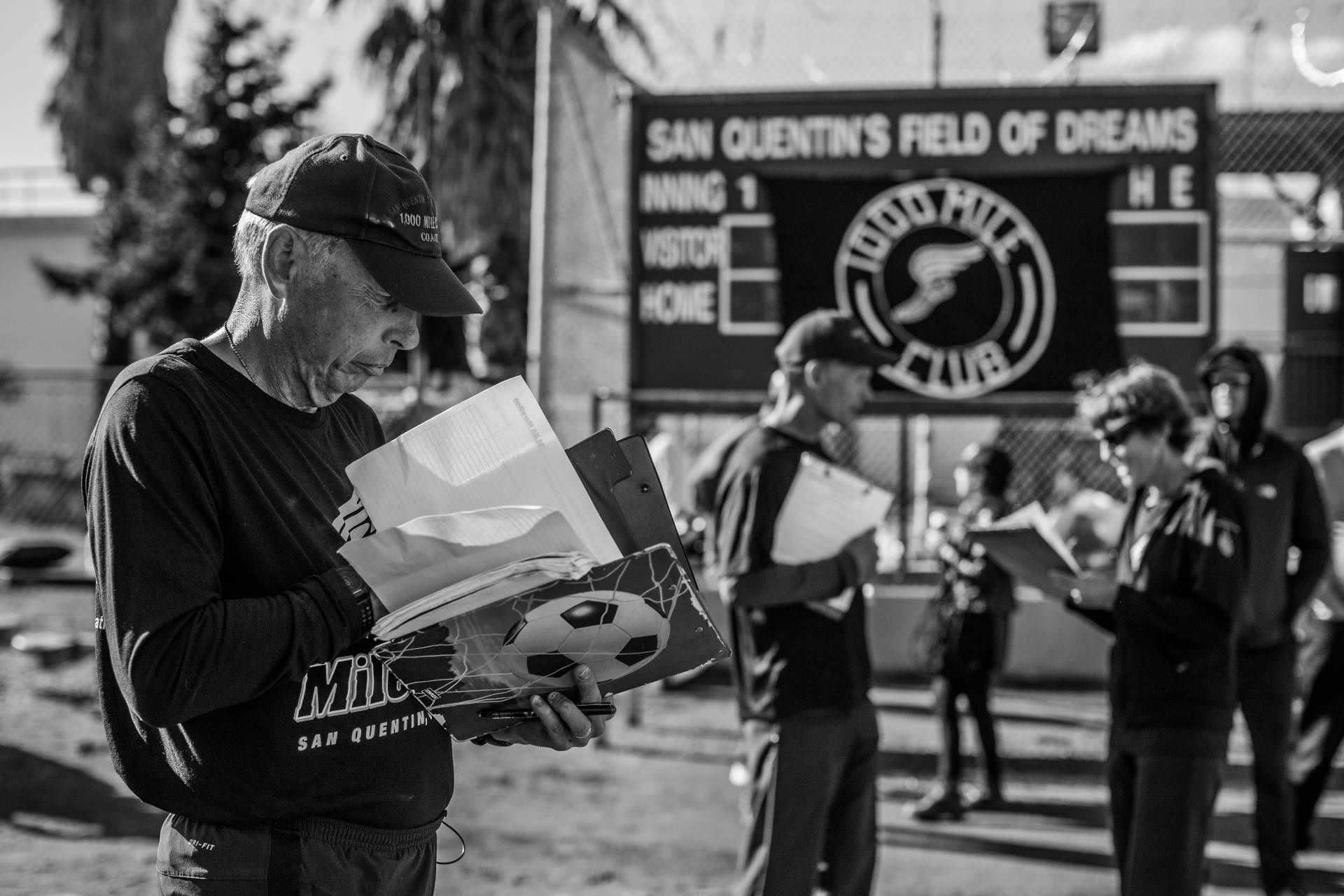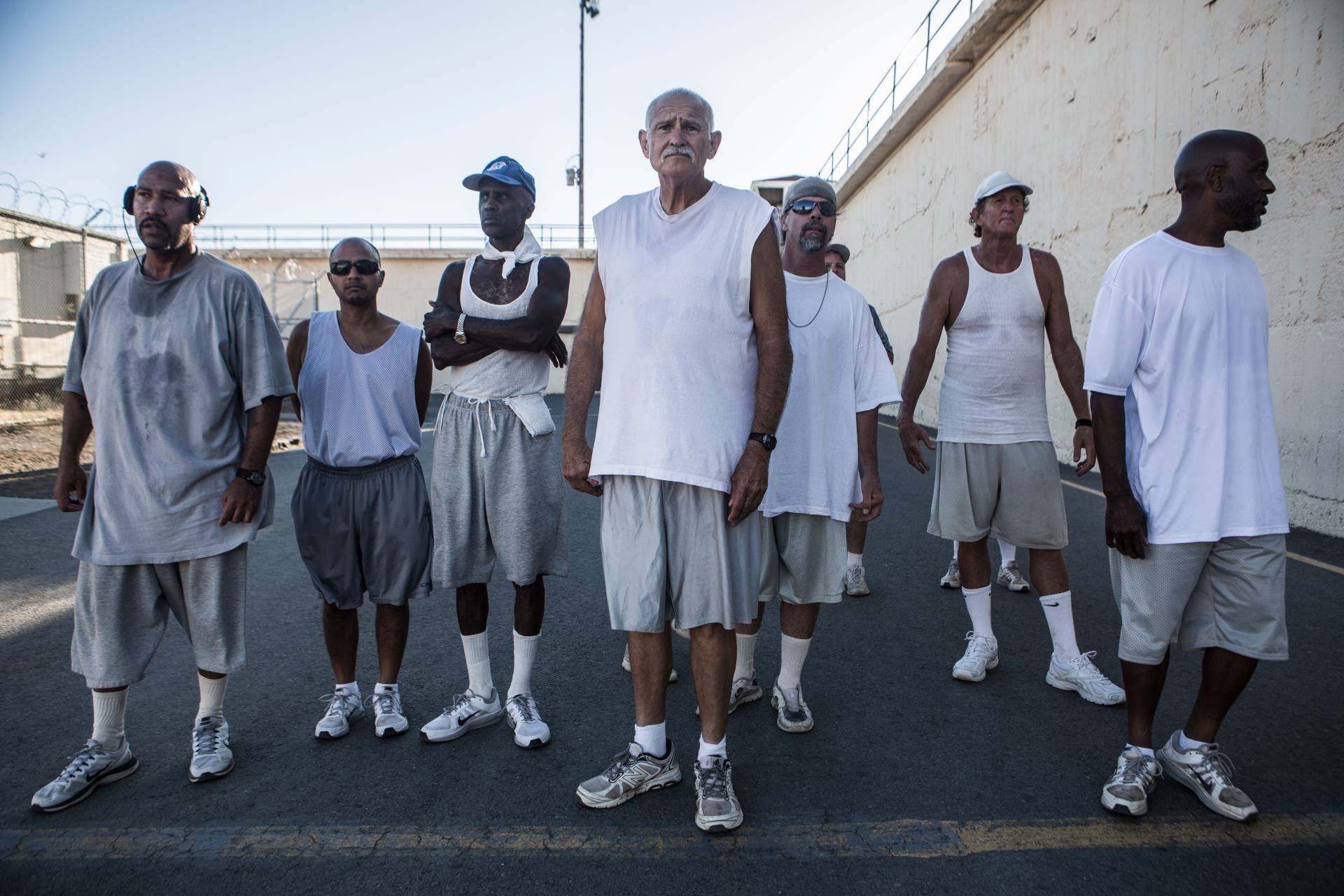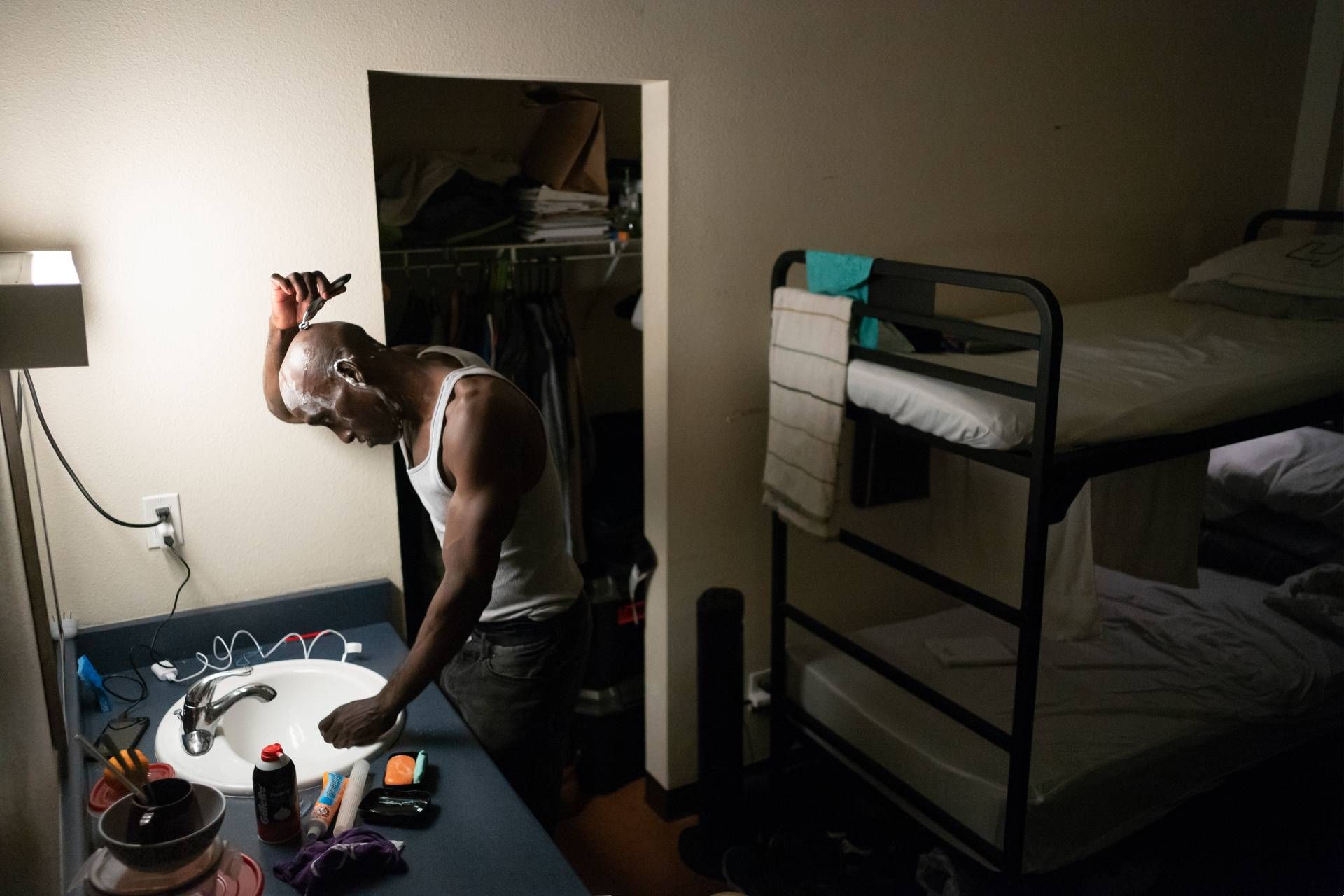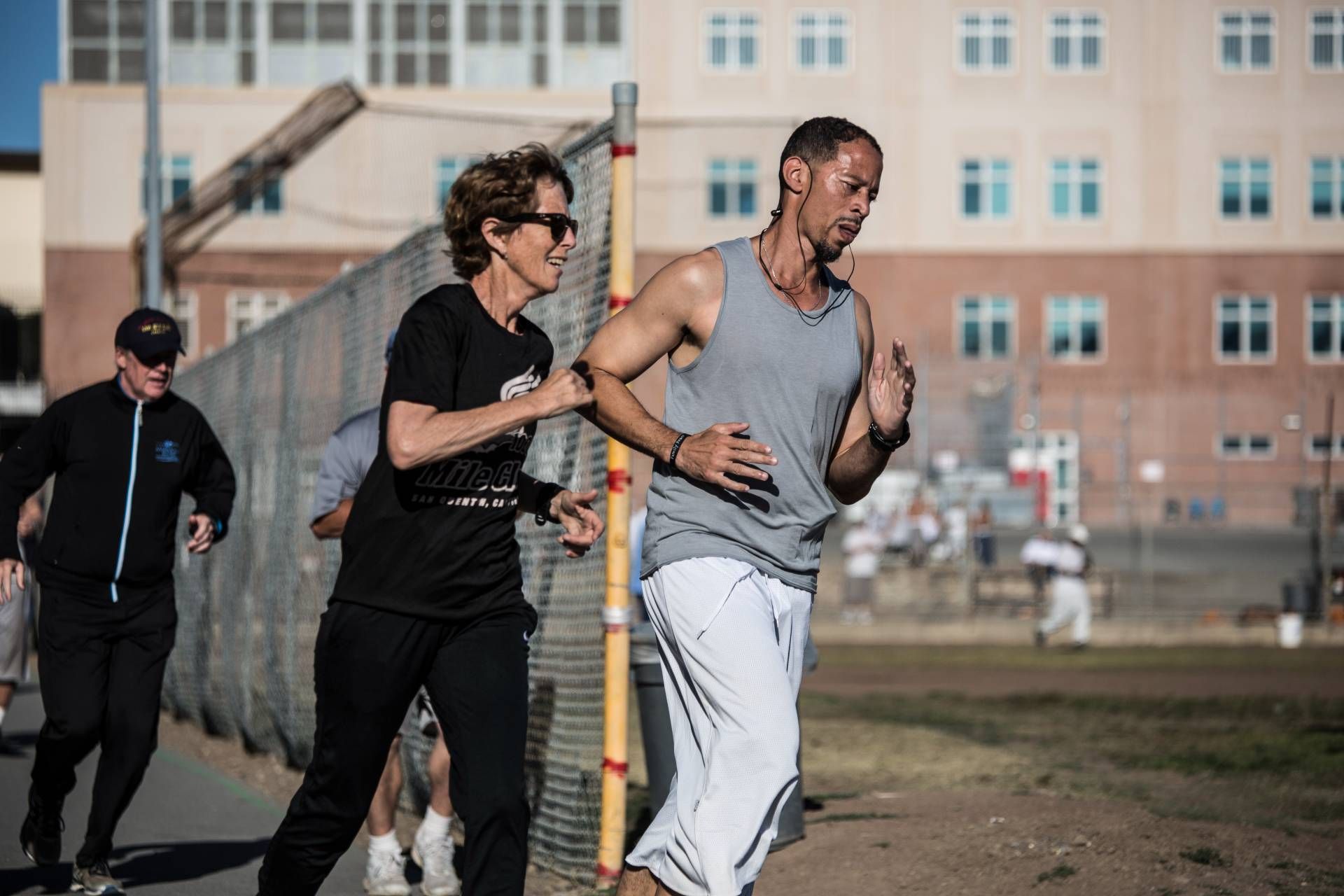Frank Ruona doesn’t care what you did. Frank cares what you’re going to do now.
Every Friday and every second Monday, the 77-year-old US Army veteran and former construction company manager arrives at the gates of San Quentin State Prison. He’ll be carrying a shoulder bag covered in race numbers, a large digital timing clock and the beige card that gives him access to California’s oldest prison. You know he’ll be wearing a black cap and a T-shirt that both say ‘1,000 Mile Club’, with a logo of a shoe that has wings. He’s consistent.
Once he and a varying cast of fellow volunteer coaches are set up in the prison yard, with its scrubby grass, exercise equipment and dusty baseball diamond, surrounded by chainlink fences and a 10m-high wall interspersed with watch towers, the runners will arrive. To a man, they have committed serious crimes and are paying for them with long stretches of incarceration. They have made a commitment to Frank: to run a total of a thousand miles or more during their time in San Quentin and, more specifically, to build their distance over a year to culminate in a full marathon in November. That’s 105 laps of the yard, six right-angled turns every lap, dodging non-participating prisoners and free-to-leave Canada geese. They will run knowing that at any moment an alarm could sound that means they need to stop and sit where they are until whatever emergency it is this time has cleared.
‘Frank cares, not by what he says, but by showing up,’says Rahsaan ‘New York’ Thomas, 52, who joined the club while serving 55 years to life. ‘We deal with a lot of abandonment issues. If you’re in prison, most likely one of your parents abandoned you. When you get locked up, most of your family and friends abandon you. So having someone that consistently shows up in your life is huge. It means a lot.’
Frank, Rahsaan and two other prisoners, Tommy Wickerd and Markelle Taylor, are the stars of an inspirational new documentary about the 1,000 Mile Club. Titled 26.2 To Life, it depicts their daily existence in San Quentin and theirjourney to participating in the marathon – and in Markelle’s case, beyond. Now 51, he was released on parole in March2019 after 17 years and seven months inside, and six weeks later ran the Boston Marathon in 3:03:52. He had met the venerable race’s stringent qualifying standard by beating 12 other inmates to win the San Quentin Marathon.
It’s a relatively happy ending for a film that makes aconvincing case that many Americans are in prison for far longer than they need to be. ‘It’s a stark fact that theUnited States has less than 5% of the world’s population, yet we have almost 25% of the world’s total prison population,’ Hillary Clinton said in a speech about criminal justice in 2015. The film’s Korean-American director,Christine Yoo, was interested in the idea of running as a positive force in the lives of people with very little hope of release. How do you live when you’re serving a life sentence?
‘I’ve experienced the runner’s high and I can certainly understand how running can give a sense of freedom,’she says. ‘That idea of mental freedom inside a prison environment was something that really intrigued me.’
A glimpse of hope
Prisoners want to be sent to San Quentin. Sure, it’s no holiday camp. It’s decrepit and outdated, having opened in 1854. The cells are roughly four-feet-by-10-feet in size and usually hold two men. It has a large death row (546inmates), though no one has been executed since 2006 and current California governor Gavin Newsom has pledged
to close down that part of the prison. During the Covid lockdowns, life became especially hellish, with about 4,000men living in a facility with a designed capacity of 3,082 and forced to remain in their cells for 23 or 24 hours a day. Visitors were not allowed. The virus infected 2,200 and killed 28. And Frank had to stop coming in for the 1,000 Mile Club.
When you hear the name, you probably think of Johnny Cash’s live release At San Quentin, made in 1969, one of fouralbums that the country star recorded in front of different prison populations. Those are San Quentin inmates laughing during A Boy Named Sue. You can also hear their raucous cheers when he sings his song San Quentin, with its lines,‘San Quentin, may you rot and burn in hell/May your walls fall and may I live to tell/May all the world forget you ever stood/And may all the world regret you did no good.’
But San Quentin also has some comparative advantages.Look down from far enough above and you can see it’s in a prime spot on the coast of the San Francisco Bay, a mere15-minute drive from the Golden Gate Bridge. ‘So many prisons are isolated somewhere like the middle of a desert.If you have to drive two hours each way to visit or to volunteer, then you’re not going to bother,’ explains Diana Fitzpatrick, a 1,000 Mile Club coach and seasoned ultra runner who is also the current president of theWestern States Endurance Run Foundation. ‘Most prisoners are starved of that type of contact, where people come in and recognise them as human beings.’
In contrast, the Bay Area is one of America’s wealthiest liberal communities and San Quentin is right in the middle.As a result, the prison is bursting with around 60 volunteer rehabilitation programmes, of which the running club is just one. For two decades, Diana commuted past over the Richmond Bridge from her home in Marin County to her job in the East Bay, and wondered what it was like down below in that yard.‘So when this opportunity came up, it seemed like a great way to share my love of running and what running can do for a community of people.’
Meta CEO Mark Zuckerberg visited in 2015 to see the prisoners being taught coding. The Marin Shakespeare Company runs acting classes inside. Prisoners produce their own newspaper, the San Quentin News. Rahsaan wrote his stories for it on a tiny LCD word processor screen in his cell, as well as co-hosting the prisoner-made Pulitzer Prize-nominated podcast Ear Hustle. Christine was so affected by the time she spent making the documentary that she still goes back in regularly to teach film-making skills. ‘It’s become the favourite part of my life,’ she says.‘I feel so incredibly privileged to have a lot of these guys entrust me with telling their stories.’
As prison views go, the one from San Quentin yard is pretty special. You can see Mount Tamalpais in the distance, which stands at 786m. The Dipsea Race – a 7.4-mile handicapped event that’s the oldest trail race in the US – has taken place around those Marinhills since 1905. Dipsea’s proximity makes it a tangible, visible goal for San Quentin’s running prisoners, who are routinely welcomed into the Tamalpa Runners – Frank’s nearby club – when they’re released.
Frank didn’t have the idea for the 1,000 Mile Club. That was Laura Bowman, who taught at the prison, in 2005.Nor was he particularly keen when she contacted him, as Tamalpa Runners’ then-president, looking for volunteers. But when he shared an email with the rest of his club an no one replied, he thought he might as well go downhimself. ‘I was favourably impressed by the guys who came out,’ he says of his first visit. ‘I had no idea thatI’d still be there so many years later.’
As Rahsaan said, Frank communicates through his actions, not his words. Of all the people I interview for this story, he talks by far the least. Jonathan Chiu, who began his life sentence in 2004 and was released in 2020, ran five San Quentin Marathons with Frank’sencouragement. Frank was also there to meet him when he got out. ‘Any time a runner comes home, he’s there at that gate,’ Jonathan says. ‘My dad felt that his duty was only to provide financially, so I didn’t really have a father figure to look towards in other ways. Frank shows that he cares because he just comes in. He’s dedicated. And he doesn’t sugar-coat anything. He tells you what you need to do to become a better runner, because that’s his thing. It’s not about anything else. He doesn’t care about your race, or religion, or why you’re in prison. He just challenges us to be better than we were and a lot of people have never had that in their lives.’
Others have found that their ethnicity, which tends to create even starker divides in prison than in regular life, barely matters in the 1,000 Mile Club. Incarcerated Black journalist Steve Brooks wrote about it for the US magazine Sports Illustrated last year: ‘In some prisons, men are beaten and stabbed for just trying to be friends with people outside of their races… But this club is an escape from feeling the heavy weight of hate.’
Frank explains the routine for a typical year: training sessions on Monday evenings, with a race once a month, generally on Friday mornings. The club members will do a benchmark mile at the start of the year so he can check their conditioning, then run three miles in February, six in March and so on up to half and full marathon distances. It was Laura’s idea to have them working towards the 1,000-mile total, so to encourage their progress they are given patches and certificates for reaching 250, 500 and 750 miles. ‘There are guys who did 20,000 miles while they were there,’ says Frank. ‘One of the guys in the documentary, Tommy – he’s been with the club five or six years and just got to 10,000. I think it shows the value of running and commitment to a goal.’
Moving forwards
When I speak to Markelle, he can’t find his passport. He didn’t have one for the first 50 years of his life and now he’s lost it. He’s arranging to travel to Ireland to run the Cork City Marathon, his first trip abroad. Since his release he has also run the marathons in Chicago, where he was born, and New York. Last year he did Boston again, this time in 2:52:00. No wonder they called him Markelle ‘The Gazelle’ in prison.
In high school he competed in 400m and 800m events, as well as cross-country races. He earned an athletics scholarship to junior college but only lasted a year. ‘I wanted to drink and party, and then life spiralled out of control,’ he says with bleak understatement.
I debated whether to include in this article details of the offences committed by the various members of the1,000 Mile Club. In her documentary, Christine films Markelle, Rahsaan and Tommy talking about what they did. ‘It was necessary for us to know what brought them
to the starting line at San Quentin in order to present who they are today,’ she explains. Of course, it’s the gigantic, horrific turning point in each of their lives, without which their circumstances – and those of many others once a serious crime has had its aftershocks – would be entirely different. But as we established, it’s not important to Frank.‘I pretty much never question them. If they want to tell me something about their crime, I’ll listen,’ he says. His assistant coach, Diana, feels the same way. ‘I know it’s the elephant in the room, but we try to meet them where they are. If people share – and some people do – then I know, but other people don’t and I really don’t care.’
Suffice to say that every former inmate of San Quentin that I speak to has been responsible for the loss of another person’s life. You can google the rest if you want – it’s all out there. But the 1,000 Mile Club is about allowing people to be something more than their biggest mistake.
Markelle entered the prison system in 2002 and was transferred to San Quentin in 2011. ‘I really didn’t want to go there,’ he says. ‘I was at a place where I was more comfortable, learning building maintenance so that I would have a trade that would make me marketable for my first time in front of a parole board, which was coming soon.’ He knew about the running club and friends of his were involved, but he didn’t want to join.‘I just didn’t want the cold and the mud and the rain, because they would go out rain or shine.’
Running became necessary, however, in 2015, when a close friend in the prison took his own life. ‘Instead of running to work out and stay fit, I was running on my own to relieve the stress from my friend dying,’ he explains. After doing this for a while, another friend suggested again that he join the club and this time he was ready to make it part of his weekly routine.
The film captures him running the San QuentinMarathon in 2017, hunched forwards with a committed grimace, his light grey vest turned dark with sweat, lapping everyone else with ease. Frank and the other coaches count the laps, shout praise and pass out gels and fluids. Markelle looks like he’s shut out everything else – his past, his immediate surroundings, his fears of an uncertain future, just turning left, and left, and left again, until he can finally collapse on the grass.
‘Some prisoners have family visits. I can only dream of having a family that visits,’ says Markelle, who in the film says he hasn’t seen his mother in 17 years. ‘The only people I would see from the outside are these coaches. You build a family in the running community who can see you and listen to you and share with you. You feel like you’re human.’
Nelson Mandela said, ‘No one truly knows a nation until one has been inside its jails. A nation should not be judged by how it treats its highest citizens, but its lowest ones.’Christine thinks that talking to prisoners will help us to understand where we’re all going wrong. ‘As much as, of course, we want to accentuate success, it’s really important to examine failure,’ she says. ‘These are society’s failures, so essentially, this is how society failed.’
Diana agrees that getting up close is what changes minds. ‘In the abstract it’s always easy to think, “They didsomething terrible so they should pay for the rest of their lives.” But these are human beings who did something maybe when they were 20. And even though it’s now 30 years later, they’re paying over and over again. It’s a loss to them, to their families and to society that these people can’t come back and lead fulfilled lives. There’s a real opportunity for them to do good.’
And spending time with society’s failures is no punishment for those who step up to the job. According to another assistant coach, Kevin Rumon, it’s far from a selfless endeavour. ‘If you’re ever feeling like you need a boost, visit us in San Quentin. I look forward to everychance I get to go there,’ he says. ‘I get 100 times more out of this than I put in. These guys have demonstrated a… a nobility, I guess is the best way to put it. They’ve risen above their circumstances. It’s not that they’ve beaten the system, but they’ve risen above where they are. And if I can’t take something away from that, shame on me.’
Midway through our conversation, Kevin reveals, very matter-of-factly, that he is living with stage four cancer. ‘It has turned out to be one of the greatest things that ever happened to me. It was an extraordinary gift, because I’m a better person now. I absolutely love living because I’m reminded that none of us are here for very long.’ And how does he want to spend the time he has? Encouraging prisoners to run round and round a grubby yard. There must be something in it.
Beyond the finish line
The glory of completing the San Quentin Marathon doesn’t last long. There’s no medal. No space blanket. After his win, Markelle is soon hand-washing his kit in the tiny sink in his cell. Rahsaan seems delighted to have set a new record for the slowest time, trundling in with Frank jogging stiffly by his side to complete the 105th lap in 6:12:23. He returns to a top bunk covered in so many books that there is barely space for him to lie down. The coaches walk out through the gate to the real world, happy that the marathon has had its largest number of finishers ever: 13.
There’s an obvious comparison to be made between running a marathon and serving a long prison term – one step at a time, pain is inevitable, blah blah blah – but a marathon is a set distance with a clear finish line. What grates for the lifers is the uncertainty. You might want to serve out your time in San Quentin, but you don’t get to choose. And while a life sentence doesn’t always mean life, freedom is a hazy concept, just about visible but out of reach until it suddenly isn’t. In the film, Markelle, not knowing that he will be eating his first restaurant meal as a free man with Frank and his team in less than two years, optimistically talks about a possible parole hearing in 13 years’ time.
Jonathan, who entered the prison system aged 22 and left it at 38, saw getting into San Quentin as a ‘retirement goal’, saying, ‘There’s no reason for you not to think you’re gonna be there until you’re 70.’ Tommy, who’s in his fifties and has a wife he’s never lived with, is currently under the depressing impression he’ll be a free man by his 86th birthday, but continues to hope that will change. No one who coaches or runs with him in the 1,000 Mile Club, or attends the sign language classes he teaches in prison, seems to see him as anything other than a fine man who made some awful mistakes a very long time ago. ‘I have felt helpless growing old and dying in a prison cell as the person I am today. What a waste,’ he wrote in 2021.
Finishing this story is delayed by the news that Rahsaan might be getting out soon, but again, there is uncertainty. On 13 January 2022, California governor Newsom commuted his sentence alongside 52 other commutations, pardons and reprieves of sentence. Rahsaan had committed his crime in 2000 aged 29, received his sentence of 55 years and six months to life in 2003, and been imprisoned for 21 years.
‘While in prison, Mr Thomas has dedicated himself to his rehabilitation,’ the governor wrote.‘This act of clemency for Mr Thomas does not minimise or forgive his conduct or the harm it caused. It does recognise the work he has done since to transform himself.’
This was happy news, given that it should have beenanother eight years until he was officially eligible for parole, and his original sentence would have released him aged 85. Even so, it was a frustrating wait until 8 February 2023, when he finally stepped outside the San Quentin gates.
When he did, partly because of his profile on the EarHustle podcast, a lot of people were waiting for him, including several TV crews. ‘I can’t think of any time in life where I’ve ever felt so much love lined up,’ he says. ‘I came out to, like, 40 or 50 hugs waiting out there for me. It was beautiful.’
While he was in the 1,000 Mile Club, Rahsaan slowly completed three half marathons and one full marathon. He may not keep up the running to Markelle’s extent on the outside. He’s going to be pretty busy with his journalism and podcasting and an organisation he has co-founded called Prison Renaissance, which aims to connect incarcerated people to other communities.
But what he took from the group is more valuable than strong legs or a raised lactate threshold. ‘I grew up in a neighbourhood called Brownsville, Brooklyn. The police didn’t shoot a lot of us, like you see on the news, but they didn’t care. They were like, “Let the animals kill each other.” So when you feel like you’re not part of society, that you don’t have support out there, it’s really hard to make good decisions,’ he explains.
‘Now people like Frank, Diana and Kevin – they’ve let me know that people do care. If I’m struggling, I can callany of them and we’ll figure something out. Then, when you feel like people in society care about you, that they’ve gotyour back, you love society and you want to protect it. I can see the reality that there’s a lot of love and a lot of caring people out there. I want to show them that I’m worthy of the second chance that they helped me get.’
Watch 26.2 To Life from 29 Sep to 1 Oct.
Positive Steps
Other prisons giving inmates access to organised running
Oregon State Penitentiary
The prison in Salem has a quarter-mile track and an official athletics club. It was set up in the 1970s by US Olympic runner Steve Prefontaine. At one point, the waiting list to join stretched to three years.
Walpole State Prison
In 1980, the first USA Track & Field-sanctioned running club inside a prison was started by Dave McGillivray, then race director of the Boston Marathon. However, prison administrators shut it down again in the middle of the decade.
Topeka Correctional Facility for Women
The Kansas prison’s Running Free programme began in 2007 when two volunteers, Carol Hill and SuzanneMacDonald, got 25 women to take part in a 5km run. ‘How to connect to the community, handle setbacks, build up for an event – these skills have been of incredible benefit to the women,’ deputy warden Bill Cummings has said.
Running Free Alaska
Inspired by the Kansas group, Tim Alderson based himself at Hiland Mountain Correctional Center to write a master’s thesis about the impact of a structured running programme on female prison inmates. The result was Running Free Alaska, which is now a registered charity.
Washington Corrections Center
In 2017, Emily Hammargren, a teacher since 2010 at the prison in the western US city of Shelton, started a running group modelled on the 1,000 Mile Club, with Frank Ruona’s advice. In 2019, the group put on their first half marathon.
Cromhall parkrun
In January 2019, a weekly parkrun was launched in the grounds of the open prisonHMP Leyhill in South Gloucestershire. There have been 115 events to date and the most recent had 21 participants.
Start your own?
The makers of the 26.2 To Life film offer support to those who want to start new 1,000 Mile Clubs in prison
This post was originally published on this site be sure to check out more of their content.














